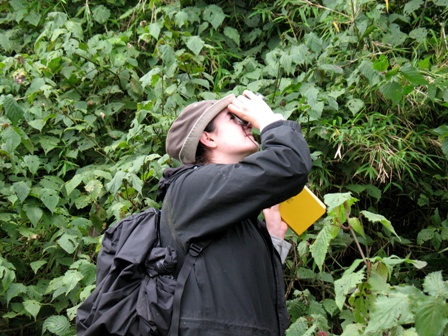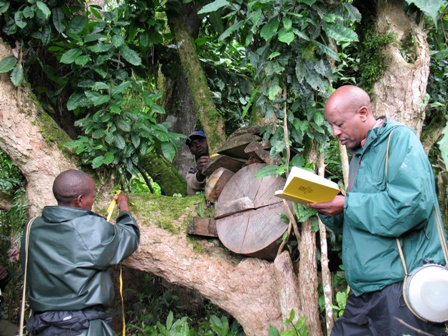Arriving
at ITFC on April 16 2009, I was greeted by half the staff, welcoming me
and expressing their anticipation of my arrival. The accommodation I was
shown was spacious, warm, and instantly felt like home as it would be
for the following three weeks. A quick tour around the station made
clear how self sufficient the station is, with solar power and rain
water collection in each building, while at the same time having
wireless internet! However, I especially appreciated the
beautiful lookout from the shower window over Bwindi Impenetrable
National Park.

The next
day, I started my fieldwork , as I could not waste time. I spent time
sampling in the Northern sector, down in the Mubwindi swamp, around
Ruhija and the bamboo zone, my favorite. Hiking up and down the slopes
of Bwindi for hours is strenuous, but I definitely felt rewarded by the
successful collection of data, as well as the beautiful surroundings.
The rich diversity of flora and fauna makes Bwindi most idyllic. From
monkeys to baboons, gorillas to elephants, you are bound to run into
some type of wildlife during your time in Bwindi.
 Each day,
a group of seven of us would set off for our data collection. The senior
field assistants were experienced and knowledgeable about species names
and locations throughout the forest. Casual labourers, helping with
trail cutting, allowed for interaction with the local community and
ensured the project was in some way helping support the local economy.
The other student volunteers present at ITFC were an absolute essential
part of my experience. Their support, friendship, laughter and great
company was truly a valued part throughout these weeks. Also, the
friendly support staff at the ITFC is always willing and available to
help and make your work go smoothly and enjoyable. The enthusiasm about
research at the ITFC among all staff members makes you feel like your
work is important for a greater cause and can make a difference.
Each day,
a group of seven of us would set off for our data collection. The senior
field assistants were experienced and knowledgeable about species names
and locations throughout the forest. Casual labourers, helping with
trail cutting, allowed for interaction with the local community and
ensured the project was in some way helping support the local economy.
The other student volunteers present at ITFC were an absolute essential
part of my experience. Their support, friendship, laughter and great
company was truly a valued part throughout these weeks. Also, the
friendly support staff at the ITFC is always willing and available to
help and make your work go smoothly and enjoyable. The enthusiasm about
research at the ITFC among all staff members makes you feel like your
work is important for a greater cause and can make a difference.
On a
personal level, this experience taught me a lot about myself. There was
plenty of time for relaxing, taking a walk through Ruhija village,
admiring the beautiful scenery while still accomplishing all the data
collection required. My time at Bwindi was short but definitely some of
the best weeks of my life! I look forward to visiting again in the near
future and encourage anyone to take the opportunity to visit this
beautiful place if given the chance. I know I would go back in a
heartbeat!
My field research at Bwindi included the recording of the species and
diameter of trees greater than 10 centimetres at breast height, from 15
transects, each 200 metres long and 20 metres wide. The transects were
located across a broad range of vegetation types, slope aspects and
slope gradients. For a subset of the trees, also height was assessed, to
develop a relationship between tree height, species and diameter for
biomass calculation. Data collected in the field will be used in
combination with remote sensing and geographical information data to
test and adapt existing methods for assessing biomass, and derived from
that, carbon, from radar and other remote imagery. So far, these methods
have been developed and found successful in relatively flat terrain. My
work is a first test for its use in an environment of steep slopes: and Bwindi is certainly a good place for that!

